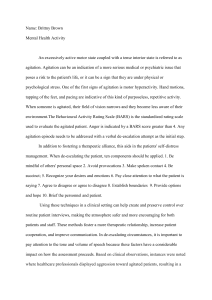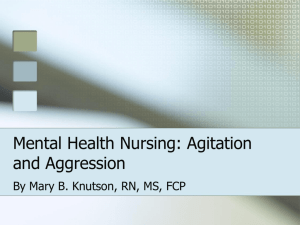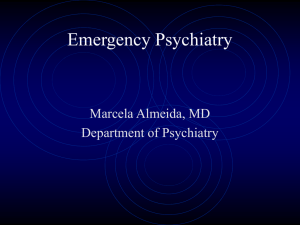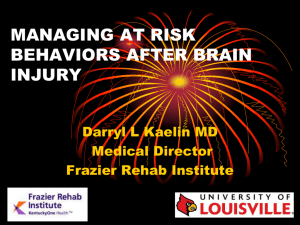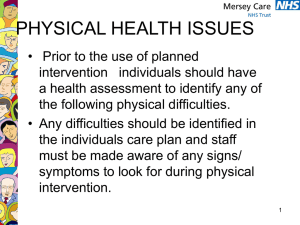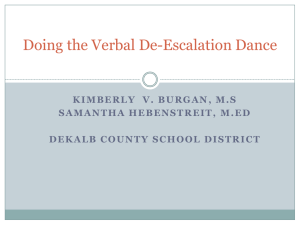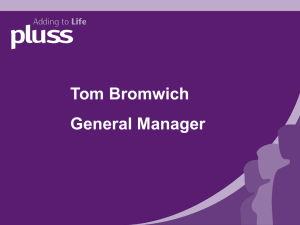Psychiatric Emergencies
advertisement
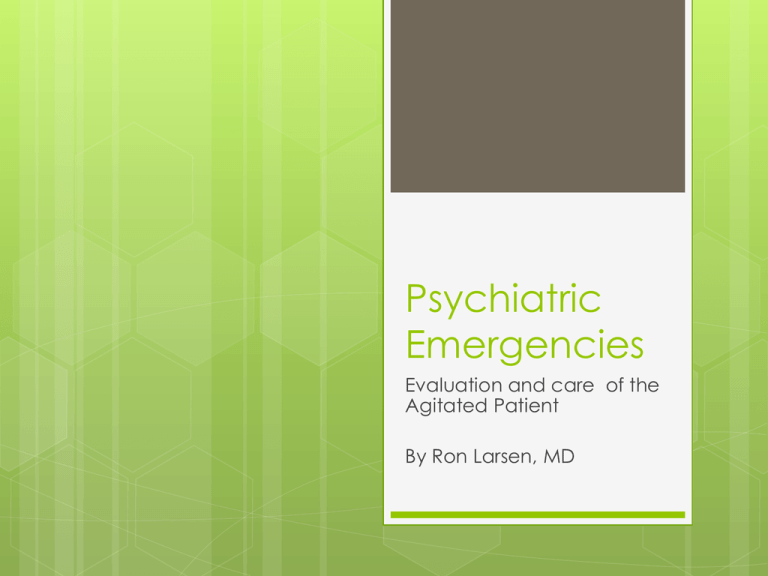
Psychiatric Emergencies Evaluation and care of the Agitated Patient By Ron Larsen, MD At the end of this session you will be able to: Identify common Medical and Psychiatric causes of agitation Provide verbal de-escalation of the agitated patient Provide Psychiatric evaluation of the agitated patient Identify psychopharmacological treatments for the agitated patient Agitation in emergency settings – 1.7 million episodes annually in the US • • • Agitation is an extreme form of arousal associated with increased verbal and motor activity. Agitation can lead to aggressive violent behaviors - with harm to patients, others, property - and is a leading cause of hospital staff injuries Agitation can result from a myriad of origins, and its treatment is multifaceted, with pharmacology playing only one part. Starting with a case: Male brought in as a John Doe found wondering in the street by the Boise Police Appears to be in mid 40s and disoriented, belligerent with the police, mildly disheveled That’s all the info you have, so what could be going on with him and what do you want to do next? Develop a broad differential: Observe closely in a safe environment with support and obtain collateral information VS including O2 Sat and BG Obtain Utox, CBC, Chem panel PE MSE including orientation, memory, speech and fluctuations in presentation Conditions that may cause agitation: • General medical conditions: Head trauma Hypoxia Metabolic (hyponatremia, hypocalcemia, hypoglycemia) Toxic level of medications (psych, anti-seizure) Seizure (postictal) Encephalitis, meningitis or other infection Encephalopathy (liver or renal failure) Thyroid disease Environmental toxins Conditions that may cause agitation: • Intoxication/withdrawal Alcohol Recreational drugs (cocaine, ecstasy, ketamine, bath salts, inhalants, meth) • Psychiatric Disease Psychotic disorders Mania Agitated depression Anxiety disorders John Doe’s labs: Utox + cocaine Na: 140 K+:3.9 Mg:2.2 Creat:1.0 BUN:14 ALT:33 AST:49 ALK phos:43 WBC:10.8 Hct:44 BP:130/94 HR:108 Temp:37.1 PE: psychomotor agitated, paranoid appearing How to manage this patient? Acute cocaine intoxication Check EKG for evidence for MI Could be an exacerbation of a primary psychotic illness such as schizophrenia Tx with nothing, benzos, or antipsychotics depending on level of agitation and paranoia Be aware of behavioral predictors of violence: Past hx, circumstances, substance abuse and dependence, ASP The story evolves: When the RN attempts to do the ECG, the patient jumps up and screams, “Get away from me! You are trying to stop my heart! Get away from me!” When you enter the room he is standing, looking at the door like he is getting ready to bolt How to de-escalate a patient Use a calm voice Sit down with the patient Maintain adequate physical distance of at least 6 feet, equal distance from the door Attempt to establish rapport Listen to the patient’s concerns Tell the patient what you want to do When verbal de-escalation is not enough: When there is risk of imminent harm and verbal de-escalation has been ineffective pharmacologic supports or physical restraints may be needed. Substance abuse carries a 30X increase risk than the general population Mental illness carries a 9X greater risk than the general population Pharmacologic Support: Benzodiazepines • • • Lorazepam is one of the most useful meds in an emergency. In the first 24 hours, agitation is as effectively addressed with lorazepam as with antipsychotics, even if psychosis is present Usual dose is 1-2 MG IM, IV, or PO Q 1-2 hours Can be additive with other agents, however, resulting in excessive sedation and respiratory depression Pharmacologic Support: Antipsychotics • • • Antipsychotics can be quite effective in reducing agitation IM Antipsychotics – Haloperidol 1-5 MG IM Q 1 hour, NTE 20-30 MG/24 hours PO Antipsychotics – Risperidone 1-2 MG PO, NTE 4 MG /24 hours (also comes in rapid melting tab called Risperdal M-tab) - Olanzapine 10-20 MG PO, NTE 20 MG/24 hours (also comes in a rapid melting wafer called Zydis) - Haloperidol 1-5 MG PO Q 1-2 hours, NTE 30 MG in 24 hours Findings that require immediate Evaluation: • Symptoms Loss of memory, disorientation Severe headache Extreme muscle stiffness or weakness Heat intolerance Psychosis (new onset) Difficulty breathing Findings continued: • Signs Abnormal vital signs: pulse, BP, or Temp Overt trauma One pupil larger than the other Slurred speech Incoordination Seizures Hemiparesis Psychiatric Evaluation of the Agitated patient Make visual observations before a direct patient interview, with attention to verbal and nonverbal interaction with the examiner Obtain collateral information while deescalation is in process Once it is determined that the patient does not have an acute medical problem, the first question if whether the patient has a delirium Psychiatric Evaluation, First r/o delirium: • • • • Examine for disorientation, altered level of awareness, and problems directing, focusing, or sustaining attention. Observe for evidence of visual hallucinations Check for signs of language impairment, problems naming, or other cognitive deficits Also consider evidence for a chronic cognitive impairment that may be a contributing factor (hx of a brain injury, developmental disability or dementia) Psychiatric Evaluation, Next r/o intoxication or withdrawal Cocaine intoxication with pupillary dilation, perspiration, vomiting, confusion, dyskinesias, dystonias, and seizures Opiate intoxication with pupillary constriction and slurred speech Alcohol withdrawal associated with increased BP and pulse, sweating, hand tremor, anxiety, and transient visual or tactile hallucinations Psychiatric Evaluation, Then consider Psychosis • • • • Agitation due to a known Psychiatric disorder can best be assessed with the help of collateral information Schizophrenia is usually first diagnosed in the late teens and early twenties Mania and Agitated Depression have an episodic course Anxiety disorders also have a life-long course starting in the late teens and early twenties As a last resort – Guidelines for the use of restraints The use of restraints puts patients at risk for physical injury and death and can be traumatic even without physical injury. Unless the patient is actively violent, verbal de-escalation should be tried first. Medications should be offered and an effort made to involve the patient in decisions about medications Restraint guidelines If the patient is an immediate danger to self or others, restraints are indicated If the restrained patient will engage in a reasonable dialog, verbal de-escalation efforts should continue, including getting the patients input on medication. Medication should be administered to calm a patient who has been placed in restraints. Restraints continued All patients in restraints should be monitored to assess response to interventions and to prevent complications from this interventions. Treatment should be directed toward minimizing time in restraints and allowing the patient to regain control Adhere to CMS and TJC standards for seclusion and restraints Management of agitation Summary • • • • • • Obtain a brief hx and VS (with O2 Sat and BG) Consider findings that require immediate evaluation and treatment Balance evaluation and management of the patient simultaneously Whenever possible de-escalate to calmness with a verbal approach alone Establish a working diagnosis before instituting appropriate pharmacologic intervention Avoid the restraint process if at all possible
